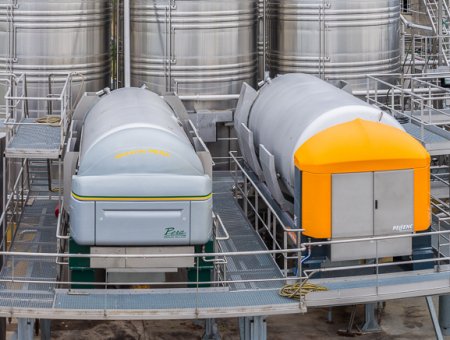Press
Wine presses are essential pieces of equipment in the winemaking process, used to extract the juice from the grapes. This crucial stage, which precedes fermentation, plays a decisive role in the quality of the final wine.
Presses are used to process different types of grapes and musts, from mechanically or manually harvested grapes, red or white varieties and even must fermented after devatting. Each of these requires special attention and a specific type of pressing to preserve its intrinsic qualities.
Different types of wine press exist in the wine industry, each with specific work objectives and a variety of component parts, meeting the needs of winegrowers to produce quality wines.
Presses are used to process different types of grapes and musts, from mechanically or manually harvested grapes, red or white varieties and even must fermented after devatting. Each of these requires special attention and a specific type of pressing to preserve its intrinsic qualities.
Different types of wine press exist in the wine industry, each with specific work objectives and a variety of component parts, meeting the needs of winegrowers to produce quality wines.

Purpose of the presses
The main aim of the presses is to extract the juice from the grapes while preserving the quality of the grapes and the must as much as possible. Specific objectives include- Efficient extraction: Maximising the quantity of juice extracted while minimising losses.
- Must quality: To ensure that the extracted must retains an optimal aroma and flavour profile.
- Marc management: Managing the solid parts (marc) in such a way as to avoid any alteration to the must.
Different types of press
There are several types of press, each with its own specific characteristics and uses depending on the style of wine desired and winemaking practices.Traditional presses
These presses use a screw or lever pressure method. Although less common today, they are still used for small production wines or traditional methods.Hydraulic presses
Using hydraulic pressure, these presses offer precise control of the pressure applied. They are appreciated for their ability to extract the juice without crushing the pips, which could lead to undesirable bitterness.Pneumatic presses
The most common in modern vineyards, these presses use an inflatable membrane to press the grapes. They allow gentle, gradual pressing, ideal for producing fine wines.Continuous presses
Used mainly for large quantities, these presses operate continuously, ensuring a high throughput of grapes. They are often used in large-scale wine production.Components of presses
Wine presses are made up of several key components, the specifics of which vary according to the type of press:- The cage (or vat): Holds the grapes during pressing. The size and shape can vary, influencing the pressure and quality of the must.
- The pressing plate: Ensures that the pressure is evenly distributed over the grapes.
- The membrane (in pneumatic presses): Inflated with air or water, it applies gentle pressure to the grapes.
- The control panel: mechanical or digital.
- Screws or pistons: Used to apply pressure in traditional and hydraulic presses.
Important settings and parameters for a pressing cycle
The operating parameters and settings of wine presses are crucial for optimising juice extraction and guaranteeing wine quality. Here are the main elements to consider:Pressing pressure
- Pressure level : The pressure applied is one of the most critical parameters. Too much pressure can crush the pips and release bitter tannins, while too little pressure may not extract enough juice.
- Progressive pressure : Using progressive pressure maximises extraction without damaging the grapes. Modern presses often allow for fine adjustments to gradually increase the pressure.
Pressing time
- Pressing cycles: Presses can be programmed for several pressing cycles, alternating between pressing and releasing phases to allow the juice to flow better.
- Total time : Pressing time should be adapted according to the type of grape and the style of wine required. Prolonged pressing can lead to the extraction of undesirable components.
Rotation speed (for continuous presses)
- Rate of entry: In continuous presses, the speed of rotation influences the rate of entry of the grapes and the quantity of juice extracted. A flow rate that is too fast can reduce extraction efficiency.
Pressing programme (for pneumatic presses)
- Automated programmes : Pneumatic presses can be programmed with specific cycles adapted to different types of grapes or musts. These programmes generally include membrane inflation and deflation sequences.
- Membrane adjustment : Membrane pressure and vacuum must be adjusted to avoid excessive or insufficient extraction.
Pressing temperature
- Temperature control : Although the temperature is not directly controllable in the press, it must be monitored, as it can affect the viscosity of the juice and the extraction of phenolic compounds.
Marc management
- Evacuation of the pomace: It is important to adjust the outlet for the pomace to avoid blockages and ensure that the must is evacuated smoothly.
Cleaning and maintenance
- Automatic cleaning: Some modern presses have automatic cleaning programmes that make maintenance easier and ensure optimum hygiene.
These parameters need to be adjusted according to the characteristics of the grapes, the type of vinification and the producer's quality objectives. Technological innovations now allow very precise settings, giving winemakers greater control over the pressing process.
Conclusion
Presses play a central role in the winemaking process, directly influencing the quality of the wine produced.Choosing the right type of press and mastering its use are crucial aspects for each winemaker, depending on the type of wine desired and the characteristics of the grapes used.ç
